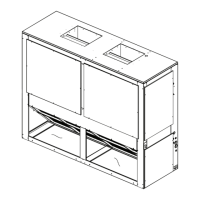44
SSA-SVX06H-EN
Maintenance
Perform all of the indicated maintenance procedures at
the intervals scheduled. This will prolong the life of the
unit and reduce the possibility of costly equipment
failure.
Fan Belt Adjustment
WWAARRNNIINNGG
RRoottaattiinngg CCoommppoonneennttss!!
FFaaiilluurree ttoo ddiissccoonnnneecctt ppoowweerr bbeeffoorree sseerrvviicciinngg ccoouulldd
rreessuulltt iinn rroottaattiinngg ccoommppoonneennttss ccuuttttiinngg aanndd ssllaasshhiinngg
tteecchhnniicciiaann wwhhiicchh ccoouulldd rreessuulltt iinn ddeeaatthh oorr sseerriioouuss
iinnjjuurryy..
DDiissccoonnnneecctt aallll eelleeccttrriicc ppoowweerr,, iinncclluuddiinngg rreemmoottee
ddiissccoonnnneeccttss bbeeffoorree sseerrvviicciinngg.. FFoollllooww pprrooppeerr
lloocckkoouutt//ttaaggoouutt pprroocceedduurreess ttoo eennssuurree tthhee ppoowweerr
ccaann nnoott bbee iinnaaddvveerrtteennttllyy eenneerrggiizzeedd..
The fan belts must be inspected periodically to assure
proper unit operation. Replacement is necessary if the
belts appear frayed or worn.
When removing or installing the new belts, do not
stretch them over the sheaves. Loosen the belts using
the belt tension adjustment bolts on the motor
mounting base.
Once the new belts are installed, using a Browning or
Gates tension gauge (or equivalent), adjust the belt
tension as follows:
1. To determine the appropriate belt deflection:
a. Measure the center-to-center shaft distance (in
inches) between the fan and motor sheaves.
b. Divide the distance measured in Step 1a by 64;
the resulting value represents the amount of
belt deflection that corresponds to the proper
belt tension.
2. Set the large O-ring on the belt tension gauge at the
deflection value determined in Step 1b.
3. Set the small O-ring at zero on the force scale of the
gauge plunger.
4. Place the large end of the gauge at the center of the
belt span; then depress the gauge plunger until the
large O-ring is even with the top of the next belt or
even with a straightedge placed across the fan and
motor sheaves.
5. Remove the belt tension gauge. The small
O-ring now indicates a number other than zero on
the plunger’s force scale. This number represents
the force (in pounds) required to give the needed
deflection.
6. Compare the “force” scale reading (Step 5) with the
appropriate “force” value listed in the Belt tension
table. If the “force” reading is outside the range,
readjust the belt tension.
NNoottee:: Actual belt deflection “force” must not
exceed the maximum “force” value shown in
Figure 44, p. 44.
Recheck the belt tension at least twice during the
first 2 to 3 days of operation. Belt tension may
decrease until the new belts are “run in”.
Figure 44. Belt tension gauge
Table 10. Belt tension measurement and deflection
Belts Cross
Section
Small Pitch
Diameter Range
Deflection Force (Lbs.)
Standard V-Belt V-Belt with Molded Notches
Min. Max. Min. Max.
A
3.0 - 3.6 3
4-1/2 3-7/8 5-1/2
3.8 - 4.8
3-1/2
5
4-1/2 6-1/4
5.0 - 7.0 4
5-1/2
5
6-7/8
B
3.4 - 4.2 4
5-1/2 5-3/4
8
4.4 - 5.6
5-1/8 7-1/8 6-1/2 9-1/8
5.8 - 8.8
6-3/8 8-3/4 7-3/8 10-1/8

